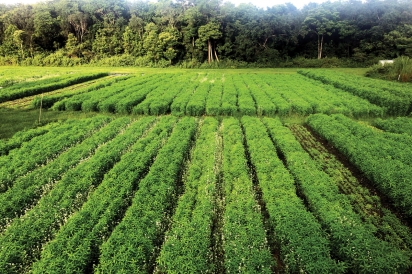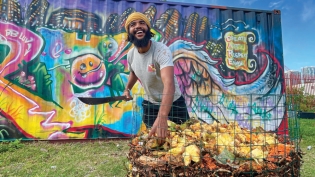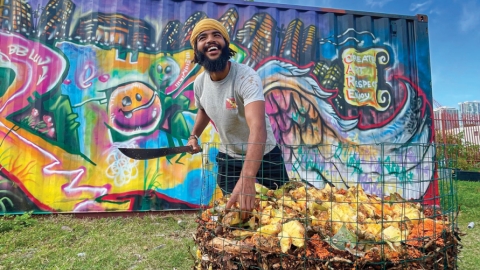The Dirt on Soil
One teaspoon of soil contains more soil microorganisms than there are people on the earth. These microbes – yeasts, algae, protozoa, bacteria, nematodes, fungi – turn organic matter into rich dark humus in the soil. What goes on underground is essential to the farmer locally and globally. By using soil health principles – keeping soil covered and disturbing it as little as possible, growing a variety of plants to diversify the soil, and growing plants throughout the year to feed the soil – farmers sequester more carbon, increase water infiltration and make a better habitat for wildlife and pollinators.
South Florida soil is unique. Much of it is sandy, sometimes barely covering the layer of rock known as Miami limestone, which doesn’t retain water or nutrients well. There’s also a soil known as marl, a gray, clay-like substance, and muck, half-decomposed organic matter that has poor aeration. It takes some work by South Florida farmers to improve its quality. They employ different techniques to build better soils that not only result in better harvests, but a healthier planet.
For agricultural pioneers who came here in the late 19th century looking to grow crops in a place that’s warm all year round, setting up the farm was a hard row to hoe – literally. Limestone covers nearly all of Miami-Dade, part of Broward and the Florida Keys. Settlers chose the higher rocky pinelands to live and farm, planting vegetables and fruit trees where they found solution holes, places where waters dissolved parts of the bedrock. Later, they dynamited holes in the limestone for planting. Next came a rock plowing machine invented to crush the oolitic limestone into smaller pieces. The gravelly soil then had to be fertilized to add necessary nutrients to grow successful crops. Plows also cut trenches, which were filled with soil and used to plant rows of tropical fruit trees like mangos, avocados and lychees.
What grows in South Florida farms and backyard gardens depends on healthy soil. But because of our geography, that soil needs a lot of help.
“The soil is unique here, different from all other parts of the U.S.” says Dr. Yuncong Li, professor of soil and water quality at the Tropical Research and Education Center (TREC) in Homestead. “Miami-Dade and Monroe have two types of soil: rocky, identical to soil in the Bahamas, and marl, covering low-lying land,” he says. These soils are calcareous, named for the calcium carbonate derived from Miami limestone. They can be sandy, loamy or gravelly.More than 85 percent of tropical fruit trees are grown on calcareous soils in South Florida, but they’re grown here because of our warm temperatures, not favorable soil characteristics, says Dr. Li.
“For small farmers, our soil is pretty poor, compared to Georgia or Alabama, where it’s easy to build organic matter,” he says. “Here, it’s hard. It takes a long time to build soil with a high organic content.” To make healthier soil, growers need to add compost, plant cover crops like sunn hemp, and rotate their crops.
It can take decades to build healthy soil. This means hard work for the small farmer, like Chris French of French Farms. “You’re trying to make the healthiest produce for you, and healthy soil with lots of living organisms and less chemical inputs,” he says. Even though French farmed at a number of places in South Florida before his current space at Agritrace Institute, he feels like he’s just getting started.
“The soil [here] is too rocky, too shallow, with deficiencies in micronutrients,” he says. His goal for creating good soil is to minimize inputs from the farmers, particularly labor. Treating for bugs and applying micronutrients are all labor-intensive. Healthy soil makes healthier plants, and that lets him spend less time “playing doctor trying to fix plant problems.”
For French, in his years of farming, he’s learning it’s easier to work with nature rather than against it in building good soil, which supports multitudes of microorganisms. One way is to reduce tillage – the act of disturbing the soil by chopping it up to make it easier to plant. “The less we go in there, the less we smash up earthworm holes, cut through mycelium [beneficial fungal networks in the soil], or bring up old weed seeds,” he says. He likes to use cover crops like buckwheat and sunn hemp when he’s not growing vegetables. “The goal is to have green plants growing, keeping the microorganisms in the soil,” he says. Other techniques are letting weeds take over until it’s planting time. Some farmers lay down strips of black plastic for weed and moisture control, planting seedlings in holes in a row. Building good soil also means adding more organic matter, like layering on horse manure, chopped-up green plants, soil and straw. French says he shovels compost on top of beds to prepare them for planting.
“If nature had its way, it would be a meadow,” says French. “We’re trying to make something buzzing with life.”
How a South Florida Farmer Builds Healthy Soil
Farmers start planting in the fall and harvest in winter and spring. French Farms’ Chris French details a year’s timeline for work in his Redland farm.
APRIL End of growing season. Remove plant residue. Cut off lettuce, mow it over, and cover with an opaque black tarp for 2-4 weeks to smother and kill weeds and remaining plants.
MAY Lightly rake the ground. Seed buckwheat. Let it grow for 30 days.
JUNE/JULY Mow buckwheat close to the ground just as it starts to make seed. If it’s weedy, might tarp again. Plant sunn hemp. Let it grow for about six weeks.
AUGUST Roll and flatten sunn hemp before it gets too fibrous. Some might mow it down or plow it over and till into the soil. Use mulch like straw. Cover with thin layer of compost. Tarp for 6 weeks.
SEPTEMBER Pull back tarps, run tractor to reshape beds without disturbing them. Apply fertilizer based on soil analysis. Plant seeds in greenhouse.
OCTOBER-MARCH Growing season. Continuous planting, fertilizing, weeding, mulching where necessary – no bare soil. Rotate crops.








